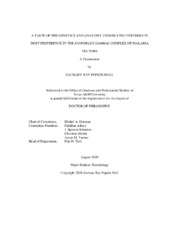| dc.description.abstract | In this dissertation, I explore three major areas of inquiry underlying vertebrate host choice in the Anopheles (An.) gambiae complex. An. coluzzii is a major vector due to its high anthropophily. Therefore, studying the genetic and anatomical basis of anthropophily is critical prior to designing transgenic control methods for this species.
First, I discuss differential expression of chemosensory genes, which could be involved in host choice, in the labella of An. coluzzii and its zoophilic sister species, An. quadriannulatus, where I identify 20 differentially expressed genes. Most intriguing are Obp26, which shows both female and An. coluzzii bias, and Obp57, which shows both female and An. quadriannulatus bias, along with very high overall expression.
Next, I present data from a series of behavioral experiments conducted on adult female An. coluzzii to determine which chemosensory organs are necessary and/or sufficient for mosquitoes to activate host-seeking, respond to host odors, and blood feed from an artificial membrane feeder. The antennae are by far the most important organs for host-seeking activation: their ablation abolishes host odor responses in a dual-port olfactometer, substantially reduces host-seeking activation, and substantially reduces blood feeding. The maxillary palps and CO2 are not necessary to activate host-seeking, and labella ablation does not significantly reduce host odor response despite generating physiological stress.
Finally, I analyze the molecular evolutionary patterns of the gustatory receptor genes (Grs) in six species of the An. gambiae complex to identify Grs that are potentially involved in vertebrate host choice. There are sixteen Grs with McDonald-Kreitman (MK) test results suggestive of positive selection, twelve with MK test results suggestive of purifying selection, eight with joint Tajima’s D/Fay and Wu’s H test results suggestive of a recent selective sweep, and four with E test results suggestive of either recovery from a selective sweep or background selection.
In summary, these results identify new directions for the study of the genetic basis of anthropophily in the An. gambiae complex, identify the antennae as the primary organ of interest in anthropophily, and provide limited evidence of a major role in either the labella or the Grs in vertebrate host choice. | en |


